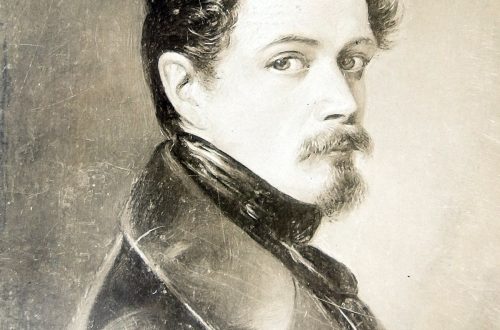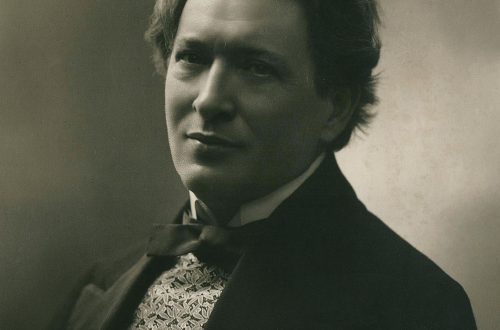
Eric Satie (Erik Satie) |
Erik Satie
Enough clouds, mists and aquariums, water nymphs and scents of the night; we need earthly music, the music of everyday life!… J. Cocteau
E. Satie is one of the most paradoxical French composers. He surprised his contemporaries more than once by actively speaking in his creative declarations against what he had zealously defended until recently. In the 1890s, having met C. Debussy, Satie opposed the blind imitation of R. Wagner, for the development of the emerging musical impressionism, which symbolized the revival of French national art. Subsequently, the composer attacked the epigones of impressionism, opposing its vagueness and refinement with the clarity, simplicity, and rigor of linear writing. The young composers of the “Six” were strongly influenced by Sati. A restless rebellious spirit lived in the composer, calling for the overthrow of traditions. Sati captivated the youth with a bold challenge to philistine taste, with his independent, aesthetic judgments.
Sati was born into the family of a port broker. Among relatives there were no musicians, and the early manifested attraction to music went unnoticed. Only when Eric was 12 years old – the family moved to Paris – did serious music lessons begin. At the age of 18, Sati entered the Paris Conservatory, studied harmony and other theoretical subjects there for some time, and took piano lessons. But dissatisfied with the training, he leaves classes and volunteers for the army. Returning to Paris a year later, he works as a pianist in small cafes in Montmartre, where he meets C. Debussy, who became interested in the original harmonies in the improvisations of the young pianist and even took up the orchestration of his piano cycle Gymnopédie. The acquaintance turned into a long-term friendship. Satie’s influence helped Debussy overcome his youthful infatuation with Wagner’s work.
In 1898, Satie moved to the Parisian suburb of Arcay. He settled in a modest room on the second floor above a small cafe, and none of his friends could penetrate this refuge of the composer. For Sati, the nickname “Arkey hermit” was strengthened. He lived alone, avoiding publishers, avoiding the lucrative offers of theaters. From time to time he appeared in Paris with some new work. All musical Paris repeated Sati’s witticisms, his well-aimed, ironic aphorisms about art, about fellow composers.
In 1905-08. at the age of 39, Satie entered the Schola cantorum, where he studied counterpoint and composition with O. Serrier and A. Roussel. Sati’s early compositions date back to the late 80s and 90s: 3 Gymnopedias, Mass of the Poor for choir and organ, Cold Pieces for piano.
In the 20s. he began to publish collections of piano pieces, unusual in form, with extravagant titles: “Three Pieces in the Shape of a Pear”, “In a Horse’s Skin”, “Automatic Descriptions”, “Dried Embryos”. A number of spectacular melodic songs-waltzes, which quickly gained popularity, also belong to the same period. In 1915, Satie became close to the poet, playwright and music critic J. Cocteau, who invited him, in collaboration with P. Picasso, to write a ballet for S. Diaghilev’s troupe. The premiere of the ballet “Parade” took place in 1917 under the direction of E. Ansermet.
Deliberate primitivism and emphasized disregard for the beauty of sound, the introduction of the sounds of car sirens into the score, the chirping of a typewriter and other noises caused a noisy scandal in the public and attacks from critics, which did not discourage the composer and his friends. In the music of Parade, Sati recreated the spirit of the music hall, the intonations and rhythms of everyday street melodies.
Written in 1918, the music of “symphonic dramas with the singing of Socrates” on the text of Plato’s genuine dialogues, on the contrary, is distinguished by clarity, restraint, even severity, and the absence of external effects. This is the exact opposite of “Parade”, despite the fact that these works are separated by only a year. After finishing Socrates, Satie began to implement the idea of furnishing music, representing, as it were, the sound background of everyday life.
Sati spent the last years of his life in seclusion, living in Arkay. He broke off all relations with the “Six” and gathered around him a new group of composers, which was called the “Arkey school”. (It included composers M. Jacob, A. Cliquet-Pleyel, A. Sauge, conductor R. Desormières). The main aesthetic principle of this creative union was the desire for a new democratic art. Sati’s death passed almost unnoticed. Only in the late 50s. there is a rise in interest in his creative heritage, there are recordings of his piano and vocal compositions.
V. Ilyeva





